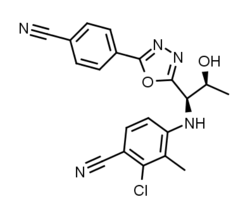RAD140
RAD140 is an investigational selective androgen receptor modulator (SARM) devoloped as a future substitute of exogenous Testosterone replacement therapy (TRT). Some of the benefits under investigation are for the treatment of conditions such as muscle wasting and skeleton wasting (Osteoporosis), caused by breast cancer, RAD140 is currently under development by Radius Health, Inc. (RDUS).[1][2][3][4]
 | |
| Identifiers | |
|---|---|
| |
| CAS Number | |
| PubChem CID | |
| ChemSpider | |
| UNII | |
| Chemical and physical data | |
| Formula | C20H16ClN5O2 |
| Molar mass | 393.83 g·mol−1 |
| 3D model (JSmol) | |
| |
| |
In early 2020 a case report of drug-induced liver injury following use of RAD 140 was published. This report (alongside another case report of liver injury caused by a SARM) has reignited fears about the safety of SARMs being used without medical supervision or advice, including RAD 140. [5] RAD 140 is still is in the first stage of clinical trials with the results expected in late 2020. When released these trials will share the safety, toxicity and potential adverse effects of RAD 140.
Animal studies
According to a study conducted by researchers at the University of Southern California, Los Angeles, RAD 140 appears to be safer than testosterone replacement therapy (TRT) in rats. Further research is required to determine if RAD 140 is also safer than TRT in human subjects. [6]
Another study conducted in February 2011 found that RAD 140 (Testolone) slightly increased lean muscle mass when used in primate subjects, by targeting androgen receptors in skeletal tissue. These measured increases in lean muscle mass were not statistically significant, however, this may be due to the small group sizes (n = 3) and relatively large standard deviations.[7]
See also
References
- Jayaraman A, Christensen A, Moser VA, Vest RS, Miller CP, Hattersley G, Pike CJ (April 2014). "Selective androgen receptor modulator RAD140 is neuroprotective in cultured neurons and kainate-lesioned male rats". Endocrinology. 155 (4): 1398–406. doi:10.1210/en.2013-1725. PMC 3959610. PMID 24428527.
- Hamson DK, Wainwright SR, Taylor JR, Jones BA, Watson NV, Galea LA (September 2013). "Androgens increase survival of adult-born neurons in the dentate gyrus by an androgen receptor-dependent mechanism in male rats". Endocrinology. 154 (9): 3294–304. doi:10.1210/en.2013-1129. PMID 23782943.
- Miller CP, Shomali M, Lyttle CR, O'Dea LS, Herendeen H, Gallacher K, et al. (February 2011). "Design, Synthesis, and Preclinical Characterization of the Selective Androgen Receptor Modulator (SARM) RAD140". ACS Medicinal Chemistry Letters. 2 (2): 124–9. doi:10.1021/ml1002508. PMC 4018048. PMID 24900290.
- Yu Z, He S, Wang D, Patel HK, Miller CP, Brown JL, Hattersley G, Saeh JC (December 2017). "Selective Androgen Receptor Modulator RAD140 Inhibits the Growth of Androgen/Estrogen Receptor-Positive Breast Cancer Models with a Distinct Mechanism of Action". Clinical Cancer Research. 23 (24): 7608–7620. doi:10.1158/1078-0432.CCR-17-0670. PMID 28974548.
- Flores, Joan Ericka; Chitturi, Shivakumar; Walker, Sarah (2020). "Drug‐Induced Liver Injury by Selective Androgenic Receptor Modulators". Hepatology Communications. doi:10.1002/hep4.1456. ISSN 2471-254X.
- Jayaraman A, Christensen A, Moser VA, Vest RS, Miller CP, Hattersley G, Pike CJ (April 2014). "Selective androgen receptor modulator RAD140 is neuroprotective in cultured neurons and kainate-lesioned male rats". Endocrinology. 155 (4): 1398–406. doi:10.1210/en.2013-1725. PMC 3959610. PMID 24428527.
- Miller CP, Shomali M, Lyttle CR, O'Dea LS, Herendeen H, Gallacher K, et al. (February 2011). "Design, Synthesis, and Preclinical Characterization of the Selective Androgen Receptor Modulator (SARM) RAD140". ACS Medicinal Chemistry Letters. 2 (2): 124–9. doi:10.1021/ml1002508. PMC 4018048. PMID 24900290.